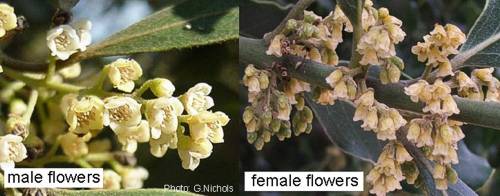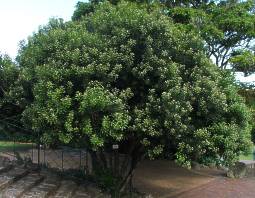Euclea natalensis
Euclea natalensis A.DC.
Family: Ebenaceae
Common names: Natal guarri, Natal ebony, large-leaved guarri (Eng.); Natalghwarrie, berggwarrie, swartbasboom (Afr.); umTshekisani, umKhasa (Xhosa); iDungamuzi, iChitamuzi, umZimane, umTshikisane, inKunzane, inKunzi-emnyama, umHlalanyamazane, umAnyathi (Zulu); umHlangula (Tsonga)
Introduction
Euclea natalensis is an adaptable, easy-to-grow tree with a neat, dense, rounded crown of dark green foliage, decorative pale, gold-tinged new growth, and makes a useful screening plant or handsome shade tree.

Description
Description
Euclea natalensis is a shrub or small bushy tree, 4-10 m tall, with a dense, spreading crown, or under warm and well-watered conditions, a medium-sized tree 12-18 m tall with spreading branches. It has a spread of 5-10 m. The trunk is usually straight. The bark is dark grey, thin and finely cracked. Branchlets are covered in fine rusty hairs, becoming smooth with age.

The leaves are hard and leathery, dark green and shiny above and paler underneath. The lower surface is often covered with thick, velvety red hairs, the upper surface is occasionally also covered with hairs. The leaves are variable in size, shape and hairiness, most often oval to oblong with pointed, bluntly pointed or rounded tips. The veins are prominent, particularly on the upper surface. The margins are thickened and often wavy. The new growth in spring is very decorative with pale, gold-tinged, velvety hairy foliage emerging out of the dark green crown.

Euclea natalensis is dioecious (with male and female flowers borne on separate trees). The flowers are small, bell-shaped, cream to yellow and are carried in many-flowered, branched sprays in the axils of the leaves. They have a heavy, sweet scent. The male flowers contain usually 16 stamens and a minute rudimentary ovary with 2 styles. The female flowers have no staminodes.

The fruits are rounded, fleshy berries, 7-13 mm in diameter, borne on hairy stalks. They are smooth or bristly, yellow, orange, red and black, in dense, conspicuous clusters. They are edible and attract birds.
The trees flower in winter-spring (June-October) and fruit during summer (August-March), ripening in autumn. The trees growing in Kirstenbosch do not set fruit as abundantly as trees in habitat, perhaps because the male and female specimens are planted too far apart from each other.
Euclea natalensis is divided into six subspecies: subsp. angustifolia F.White, subsp. capensis F.White, subsp. magutensis F.White, subsp. natalensis, subsp. obovata F.White and subsp. rotundifolia F.White.
Conservation Status
Status
Least Concern (LC). Euclea natalensis is not threatened.
Distribution and habitat
Distribution description
Euclea natalensis is widespread, from Clanwilliam in the Western Cape, southwards and eastwards along the coast through the Eastern Cape to KwaZulu-Natal, Swaziland, Mozambique, Mpumalanga, Limpopo, Gauteng and further north to tropical east Africa into Ethiopia. It is found growing under many different conditions in a wide variety of habitats, from arid rocky scrub to dune bush, open grassveld, woodland, forest, forest margin, riverine fringes, bushveld and in swamps, from sea level to 1200 m. In arid scrub it is stunted, often less than a metre tall, while in forest or under favourable conditions it can form a handsome tree 12-18 m tall with spreading branches.
Derivation of name and historical aspects
History
The genus name Euclea means of good report, or famous, from the Greek eucleia, glory which is derived from eu- good, and kleos report, perhaps referring to the good quality ebony-type wood of some species. The species name natalensis means from Natal, now KwaZulu-Natal.
The common name guarri is the phonetic spelling of its original Khoisan name, the original meaning unknown. The Zulu name inkunzane is used to refer to a strong enema and inkunzemnyama the strong black enema.
Euclea is a small African genus of about 20 species, with 16 species in southern Africa. The genus belongs in the Ebenaceae, the Ebony Family, which contains only two genera; Diospyros and Euclea. Diospyros is a large genus of about 475 species that occur throughout the tropics and subtropics of both hemispheres, with about 94 species in Africa, and about 20 in southern Africa.
Ecology
Ecology
The flowers are worked by bees. The fruits are edible, and are eaten by birds, monkeys and people.
Uses
Use
Euclea natalensis twigs are used for toothbrushes. The roots and/or bark are used as an ingredient in a variety of traditional remedies, to treat worms, stomach disorders, toothache, headache, chest complaints and pleurisy, urinary tract infections, venereal diseases, schistosomiasis, dysmenorrhoea and for scrofulous swellings, abnormal growths on skin and leprosy. It is also used for protective sprinkling charms. Roots are pounded and boiled and used to make a black dye. The wood is heavy, hard and strong, but is not much used and is avoided as firewood in KwaZulu-Natal.

Growing Euclea natalensis
Grow
Grow Euclea natalensis in a warm position, in full sun or partial shade, with fertile soil and moderate to good water supply, particularly during the summer months. Protect from frost when young. Water generously during its first years to allow it to establish itself. This species is wind tolerant, and drought tolerant when established.
Euclea natalensis is relatively slow growing. It is suited to many different types of gardens, including windy coastal gardens, well-watered subtropical gardens as well as bushveld and woodland gardens. In an exposed, windy, coastal site it will form a low, rounded, bushy, stunted tree, whereas in a protected, well-watered garden it can be expected to grow into a handsome medium-sized, spreading tree.
Euclea natalensis is easy to grow from seed. Clean off the fleshy layer, sow in spring or summer in a well-drained seedling mix. Place in a warm position out of direct sun and keep moist. Transplant into individual pots after the first pair of true leaves has developed.
Propagate by cuttings in spring or summer while the tree is actively growing. Take sturdy, semi-hardwood heel cuttings from the previous year's growth. Place in a well-drained, well-aerated rooting medium, in multi-trays, under mist with bottom heat set at 24 °C.
References
- Coates Palgrave, M. 2002. Keith Coates Palgrave Trees of Southern Africa, edn 3. Struik, Cape Town.
- Jackson, W.P.U. 1990. Origins and meanings of names of South African plant genera. University of Cape Town, Cape Town.
- Joffe, Pitta. 2001. Creative gardening with indigenous plants. A South African guide. Briza Publications, Pretoria.
- Leistner, O.A. (ed.). 2000. Seed plants of southern Africa: families and genera. Strelitzia 10. National Botanical Institute, Pretoria.
- Palmer, E. & Pitman, N. 1972. Trees of Southern Africa. A.A. Balkema, Cape Town.
- Plants of southern Africa : an online checklist. http://posa.sanbi.org
- Pooley, E. 1993. The complete field guide to trees of Natal, Zululand and Transkei. Natal Flora Publications Trust, Durban.
- Smith, C.A. 1966. Common names of South African plants. Memoirs of the Botanical Survey of South Africa No. 35. White, F. & Verdcourt, B. 1996. Ebenaceae. Flora of tropical East Africa.
Credits
Alice Notten
Kirstenbosch National Botanical Garden
February 2010
Acknowledgments: the author thanks Anthony Hitchcock for advice on propagation.
Plant Attributes:
Plant Type: Shrub, Tree
SA Distribution: Eastern Cape, Gauteng, KwaZulu-Natal, Limpopo, Mpumalanga, Western Cape
Soil type: Sandy, Loam
Flowering season: Spring, Winter
PH:
Flower colour: Cream
Aspect: Full Sun, Morning Sun (Semi Shade), Afternoon Sun (Semi Shade)
Gardening skill: Average
Special Features:
Horticultural zones











Rate this article
Article well written and informative
Rate this plant
Is this an interesting plant?
Login to add your Comment
Back to topNot registered yet? Click here to register.